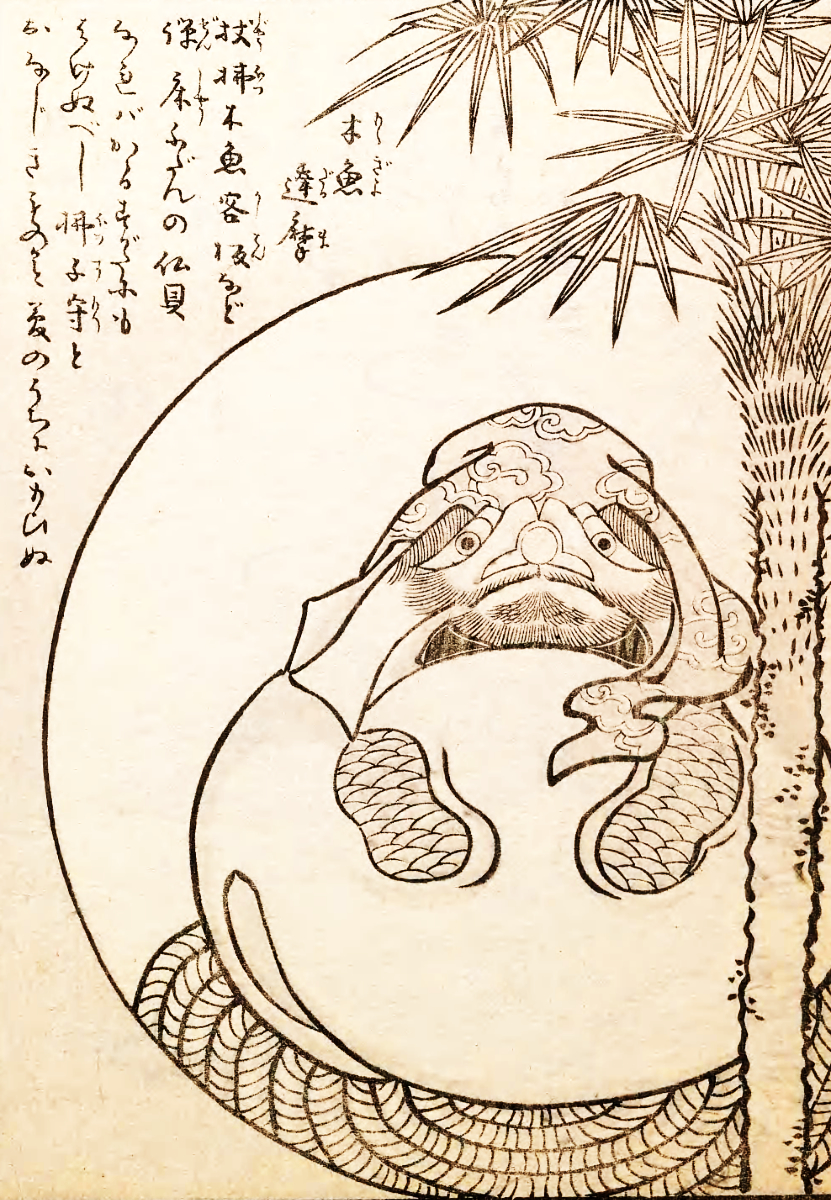Mokugyo daruma are the tsukumogami of mokugyo—fish-shaped wooden gongs used in Buddhist temples. After years of service helping monks to focus on their meditations, these gongs have also achieved enlightenment. Mokugyo have multiple purposes in a Buddhist temple. They are used to keep the rhythm when chanting sutras. They are also used to keep people awake during meditation. Because fish sleep with their eyes open, in old times it was believed that fish did not sleep. Thus the wooden fish gong represents avoiding falling asleep while meditating. Toriyama Sekien describes mokugyo daruma in Hyakki tsurezure bukuro. He says that a mokugyo might possibly gain a soul and take on the features of Daruma (aka Bodhidharma), the founder of Zen Buddhism, after nine years of being used by ascetic practitioners. Like mokugyo, Daruma is a symbol of wakefulness. Daruma is said to have meditated for nine years straight without sleeping. Due to their shared symbolism, Sekien combined these two figures of wakefulness into one tsukumogami.
| Alias Mokugyo daruma (木魚達磨) |
| Real Names/Alt Names “Wooden fish gong Daruma” |
| Characteristics Yōkai, Enlightenment and Neoclassicism, Japanese |
| Creators/Key Contributors Toriyama Sekien, ○ |
| First Appearance Japanese folklore |
| First Publisher ○ |
| Appearance List Hyakki Tsurezure Bukuro (百器徒然袋, “The Illustrated Bag of One Hundred Random Demons” or “A Horde of Haunted Housewares”, c. 1781) Vol. 2 |
| Sample Read Hyakki Tsurezure Bukuro Vol. 2 (c. 1781) [Smithsonian] |
| Description Mokugyo daruma are the tsukumogami of mokugyo—fish-shaped wooden gongs used in Buddhist temples. After years of service helping monks to focus on their meditations, these gongs have also achieved enlightenment. Mokugyo have multiple purposes in a Buddhist temple. They are used to keep the rhythm when chanting sutras. They are also used to keep people awake during meditation. Because fish sleep with their eyes open, in old times it was believed that fish did not sleep. Thus the wooden fish gong represents avoiding falling asleep while meditating. Toriyama Sekien describes mokugyo daruma in Hyakki tsurezure bukuro. He says that a mokugyo might possibly gain a soul and take on the features of Daruma (aka Bodhidharma), the founder of Zen Buddhism, after nine years of being used by ascetic practitioners. Like mokugyo, Daruma is a symbol of wakefulness. Daruma is said to have meditated for nine years straight without sleeping. Due to their shared symbolism, Sekien combined these two figures of wakefulness into one tsukumogami. |
| Source Mokugyo daruma – Yokai.com |

